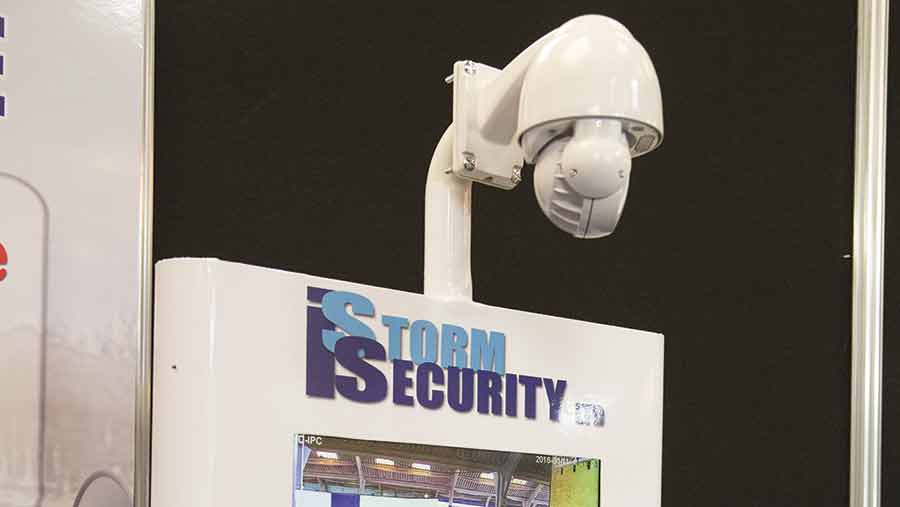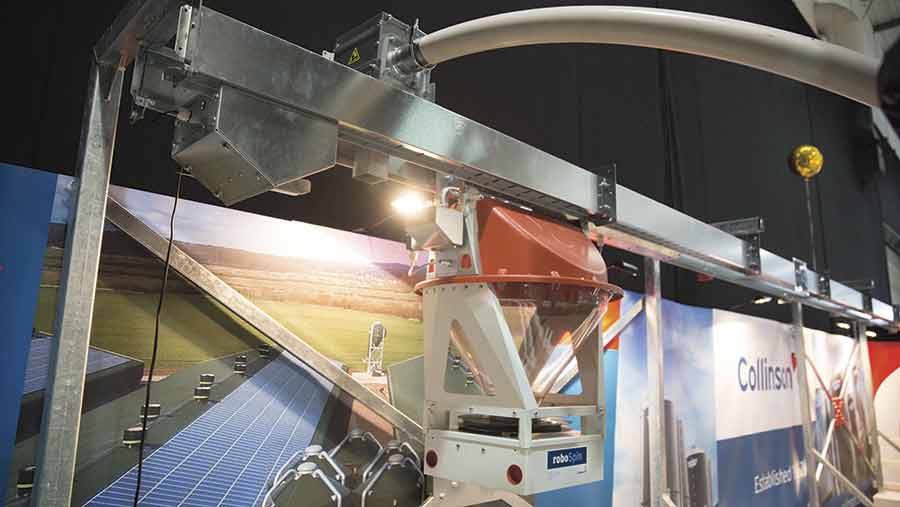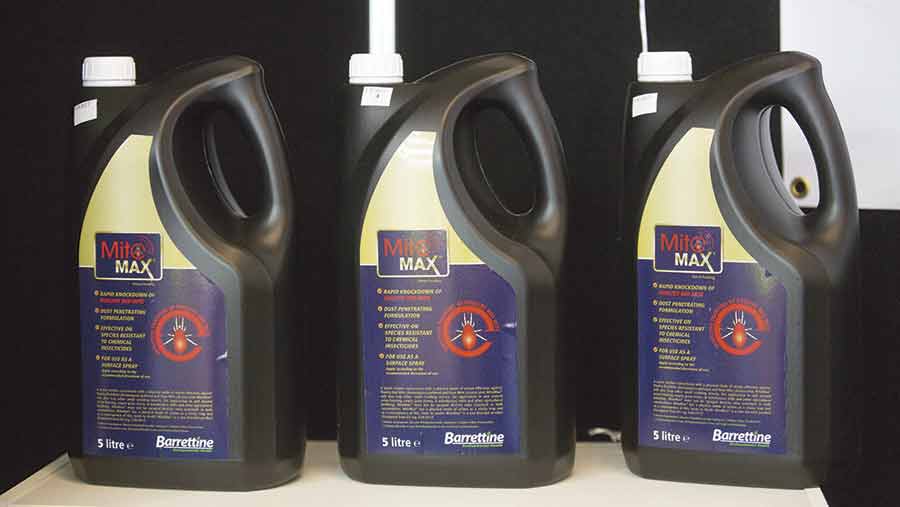Latest technology and kit for poultry farmers

From smartphone security kit worth thousands of pounds to pest traps for under a tenner, the Pig & Poultry Fair 2016 was a showcase for a wide-range of innovations.
A biennial event, the fair is usually considered the best place to launch products to the UK market, and this year was no exception.
Here’s a round-up of a selection from the event.
See also: More from the British Pig & Poultry Fair
Ceva Animal Health EggInject
Vaccinating day-old chicks is a labour intensive task, but hatcheries across Europe are saving thousands of man hours with the latest egg injection system from Ceva Animal Health.
Ceva’s EggInject system can deliver 50,000 vaccines an hour through the shell. It would take 15-20 manual operators treating up to 3,000 chicks/hour each to compete.
Ceva UK sales manager Paul Brandford explained that the machine treats the embryo at day 18 using rows of aligned needles.
The rows are set up to match specific egg tray sizes used by the hatchery. As the trays pass along a conveyor the needles drop down and penetrate the egg shells.
The needles and the injection site are then disinfected automatically by the machine’s fluid sanitation system.
Mr Brandford also pointed out that there was no wasted vaccine. Gaps, where empty eggs have been removed from trays at candling, are spotted by sensors ahead of the needle array.
The appropriate needle is then blocked and the vaccine dose withheld. There are no EggInject machines working commercially in the UK yet but dozens have been sold worldwide.
Pest Trappa Red Top Fly Trap
The Red Top Fly Trap is designed to remove millions of flies before they enter housing. Sales director Jim Cuckson said flies are attracted to the bait which sits inside the red-topped, plastic trap.
The bait is activated by a combination of water and sunlight and stimulates the female to lay eggs. Each trap attracts up to 20,000 flies producing 150 eggs per lay.
Multiplied up that accounts for three million flies per trap, Mr Cuckson said. He explained that the trap should be hung outside, about 10m (33ft) from the housing that needs protecting.
It also needs to be positioned out of the wind and at a sunlit site to activate the bait. Each one costs about £9.99 and lasts for up to 12 weeks with occasional top-ups of water.
Collinson RoboSpin

The RoboSpin is a supplementary scratch feed system designed to improve fertility in broiler-breeder units. Collinson’s Paul Hutton explained that male and female birds need to be encouraged to mix in a shed to maximise fertility.
Floor or scratch feeding is recommended to entice the birds to get together, Mr Hutton said. But manual feeding is often imprecise, can introduce disease, increases labour costs and stresses birds.
Many units avoid scratch feeding altogether even though egg fertility rates suffer. The RoboSpin overcomes these issues by running silently down a monorail over the centre of the shed.
It delivers precise quantities of feed through a spinner. The spinner rotation and speed of travel down the shed are adjusted to deliver the precise amounts of food required across widths of up to 5m (17ft).
The RoboSpin is battery powered and after making a pass it returns to a recharging dock at the end of the line. A maintenance trolley can also be fitted on the monorail for staff to move equipment up and down the shed.
Barrettine Mite Max

Environmental health company Barrettine unveiled its pesticide which tackles red mite populations within one minute of spraying.
The treatment, based on a food grade cellulose polymer, forms a sticky layer to trap the mites.
Barrettine managing director Steve Bailey explained: “It is a safe product which kills mites by encapsulating them. Because the product contains no active ingredient it is effective even against mites that have become resistant to certain chemicals.”
That also means it is not subject to biocide regulations and can be applied with birds still in occupation.
Mr Bailey added that most chemicals form a layer on the top surface and are quickly overcome by dust.
But the Mite Max formulation allows it to penetrate through the surface of litter and dust layers and into the mites’ infestation sites.
The product is on sale through Bowden and Knights Livestock and sells for about £59.50 plus VAT for a 5 litrepack. One pack is sufficient to treat about 200 sq m (240 sq yds).
iStorm Security Remote Access Livestock Monitor

One of the big pluses for iStorm’s camera system is its High Definition cameras which use a 10x or 18x optical zoom.
Unlike digital zooms, that pixelate when the operator wants to close-in on a subject, an optical system uses lenses to magnify the image.
Images remain in sharp focus even at 100m (330ft) allowing the camera operator to zoom in closely enough to check the levels in feeders and drinkers.
IStorm managing director Iain Nixon said: “It means we can get up close to the birds without entering the building and causing stress or disease risk.”
The camera images can be viewed anywhere, anytime through a smartphone, tablet or computer. “The software can send alarms for specific sheds straight to the phone and you can log in to see what the problem is wherever you are,” he added.
On a day-to-day level watching flocks without entering sheds can highlight problems such as poor ventilation if birds are clustering in certain areas. Cameras cost from £750 and a Network Video Recorder capable of handling up to four cameras is £350.
EPA Products Air Quality Monitor
Hertfordshire-based EPA Products launched its latest innovation at the Pig and Poultry Fair – an air quality monitor which assesses carbon dioxide, ammonia, temperature and humidity levels.
EPA’s managing director Andrew Williamson explained that the accurate monitoring of carbon dioxide and ammonia was an important step. “Carbon dioxide levels can build up in the winter months when temperatures are low and ventilation is running less frequently.
Temperature levels won’t always rise high enough to trigger an alarm or ventilation during these months so carbon dioxide build-ups can cause suffocation of the flock before the manager knows there is a problem.”
Likewise, ammonia can go undetected until it reaches a level where a bird’s metabolism is affected causing stress and damaging production.
The monitor, which took two years to develop, is sited high in the shed – out of the way of dust and damage.
It samples air once a minute through a tube which extends down to stock height, measuring maximum and minimum levels of the target gases and is integrated with alarm and ventilation systems. Each unit costs about £595.
Herz Poultry Biomass Boiler
Biomass boiler manufacturer Herz has launched an industrial unit designed specifically for the poultry industry. The 995kW boiler can be fuelled entirely by poultry litter, according to UK suppliers Myriad Heat and Power.
Myriad’s managing director Paul Clark said that the boiler was made with more durable stainless steel components to cope with the corrosive and abrasive fuel. Mr Clark added that the benefits of the boiler went beyond saving on fuel costs.
The boiler also offers additional revenue through the Renewable Heat Incentive scheme and potential fertiliser sales of poultry litter ash, he said.
In addition, the birds’ welfare and crop performance is improved through moisture and carbon dioxide removal in the sheds which are both given off by LPG burners, Mr Clark explained.
The combustion chamber comprises three different zones allowing more accurate control of the combustion process and improved emissions.
The boiler is also equipped with a remote monitoring system and combustion chamber camera to make maintenance easier.
Henderson Plastics Biosecurity Barrier
Henderson’s biosecurity barrier was created after an approach by a large food group which is stepping up its drive to tackle the industry’s campylobacter problem.
One of the major disease transmission routes is via staff entering poultry housing without removing outside boots and overalls.
Henderson Plastics owner Terry Henderson said traditional warning signs and notices were clearly not enough to get staff to stop and think. “We were asked to create a simple, barrier which provides a physical block and demarcation of clean areas in poultry housing,” Mr Henderson said. The finalised design was to have a wide, rectangular plastic slab about 60cm (2ft) high and about 8cm (3in) thick.
The barrier can be manufactured to any width and slots down into two brackets either side of the poultry shed entrance. It also has a small seat on top so that staff can sit down, remove boots and swing their legs over to the “clean” side. The barrier can be lifted out and removed for cleaning.
